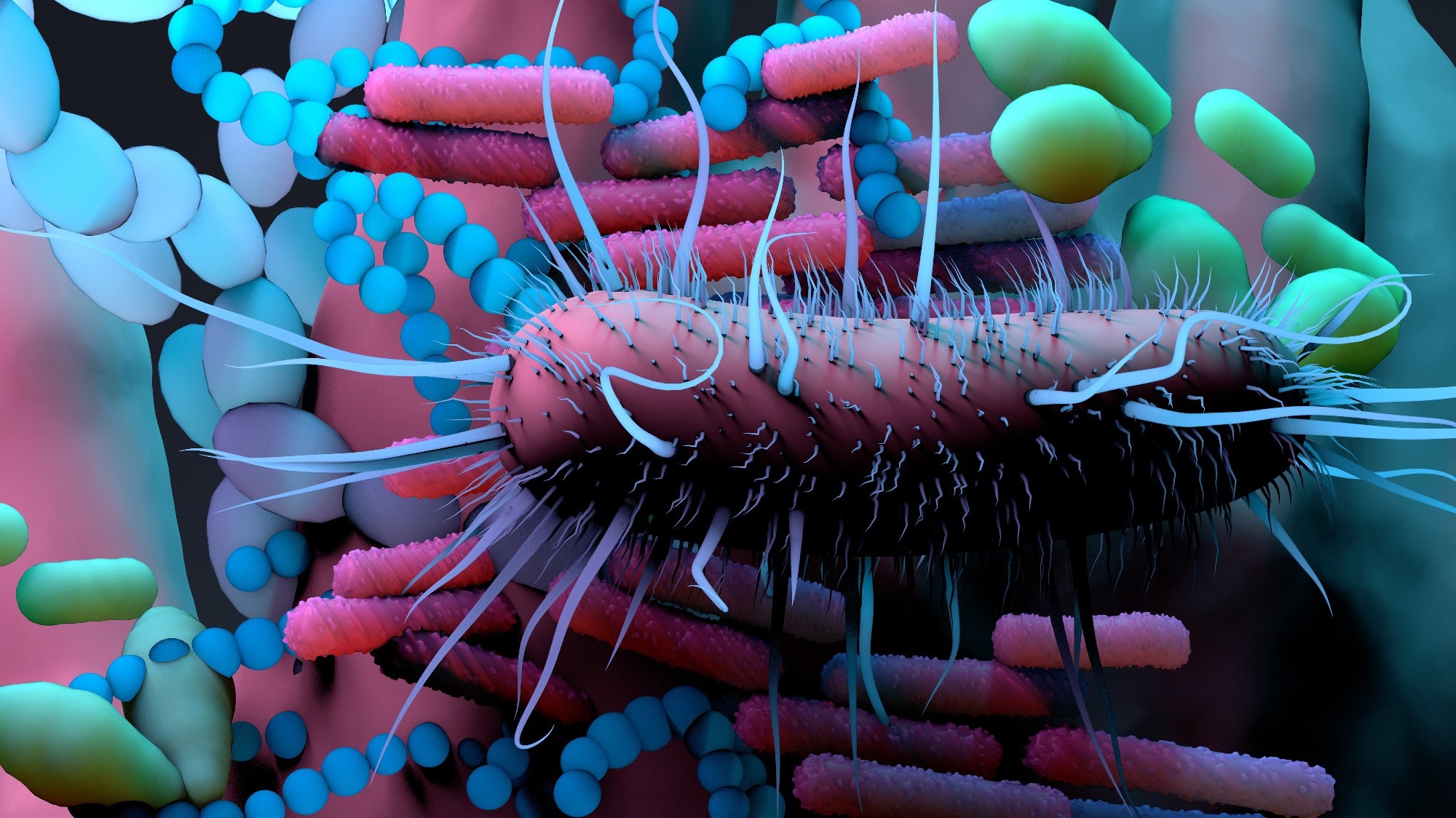The human organism is a complex ecosystem of coexisting microbiomes, including those in the gut, the skin, and the vagina in females. These play a crucial role in health and disease. However, a great deal remains to be learned about them.
A new paper recently published online in Trends in Microbiology journal reviews the systems biology approach to explore the vaginal microbiome (VMB), helping to understand its composition and function and the mechanisms by which it interacts with the host.
 Review: New perspectives into the vaginal microbiome with systems biology. Image Credit: Design_Cells / Shutterstock
Review: New perspectives into the vaginal microbiome with systems biology. Image Credit: Design_Cells / Shutterstock
Introduction
The VMB is vital in female fertility, and disruptions can be associated with pregnancy disorders, gynecologic diseases such as pelvic inflammatory disease (PID), and an array of infections involving the female genitourinary and reproductive tract. In addition, the VMB may be instrumental in affecting drug efficacy in women.
However, the VMB is little understood beyond a vague idea that a preponderance of Lactobacillus is associated with a ‘good’ state with a homogeneous community structure. Conversely, an undesirable state of the VMB exists when more diverse species are identified in greater abundance.
This latter suboptimal state is often linked to bacterial vaginosis (BV), found in one in three women during their reproductive period, which can have severe consequences on their fertility. As such, research in this area is required to understand the directionality and magnitude of such associations.
The problem
While many studies have been performed in this area, it is difficult to understand what an optimal VMB looks like because of the complex interactions between microbes and other host factors. This means that the healthy VMB can differ considerably from woman to woman and at different points in the same individual’s life cycle.
Such changes occur within days, which contrasts with the much slower shift seen with the gut, skin, and oral microbiomes, which may change over months or even years. Unfortunately, this makes cross-sectional data quite non-representative when it comes to studying the association of VMB composition, function, and disease – and thus makes most of this data less useful than it could be.
Again, the human VMB differs significantly from that of animals, as well as from culture-based models. In the former, even non-human primates fail to show the characteristic conditions of the human vagina, including the acidic pH and Lactobacillus dominance.
In the latter, some microbes are incredibly resistant to culture in vitro, while various culture conditions are used in different laboratories, depending on the media. This could make the growth environment quite different from that of the human cervix and vagina, invalidating the results of such experiments.
As such, clinical samples from which vaginal microflora are cultured, identified, and quantified form the primary source of information about the human VMB. This information is colored by experimental and host variables, which require sophisticated statistical adaptations to achieve a valid conclusion.
“While relevant to all microbiome sites, [this] is particularly applicable to the VMB because of its lack of experimental models that allow for interrogation of vaginal microbiota under controlled conditions.”
The solution
Such an impasse can be solved with a systems biology approach, where quantitative analyses are used to extract the important factors affecting the behavior and function of a microbial community. As such, “Leveraging systems biology techniques applied to other microbiomes, as well as developing novel techniques and applying these methods to the VMB, will have a significant impact on improving women’s health.”
The use of systems biology can overcome the challenges of such complex and multiple external and internal interactive networks. Furthermore, multiple approaches can be used, depending on the type of information available and the aim of the study.
Thus, statistical or data-driven methods are ideal when high-throughput data are abundant in a relatively new field of study. This can help suggest what microbial profiles are linked to disease or health. Since little is known so far about the VMB, data-driven models have predominated so far.
Conversely, based on hypotheses, mechanistic methods are better when much is already known about a system, or at least the fundamental data is available, and the need is to understand the mechanisms of cause-effect associations underlying biological function. In addition, they help to set the ranges within which microbial composition and interactions can occur in normal and abnormal situations.
Lab Diagnostics & Automation eBook

Some mechanistic methods include mass-action kinetic or population dynamics models (based on differential equations), genome-scale metabolic models (GEMs), and agent-based models (ABMs).
What has been achieved?
The systems biology approach has already helped to identify and categorize community state types (CSTs) associated with health, disease, or transitions between the two. First defined by microbial abundance, they incorporated patient demographic and health data to form hierarchical clustering groups. In addition, other methods like nearest centroid classification have been developed to overcome the inherent variation in the dataset with the former approach.
CST groupings help simplify VMB composition and thus suggest associations with community composition and function. But this is at the cost of overlooking community-specific factors specific to different taxa.
Multi-omics approaches could be integrated with systems biology strategies to identify associations with different types of community and specific metabolomics, transcriptomics, and metagenomics profiles, for instance. In addition, random forest models and other advanced machine learning models are being pressed into service to help distinguish VMBs with a predominance of different microbes, such as L. crispatus vs. L. iners or Bifidobacteriaceae.
Interestingly, neural network models have shown the superiority of metabolomics in describing the cervicovaginal environment accurately compared to either VMB composition or immunoproteomics. The integrated use of these strategies could help pick out the important drivers of VMB states in health and disease.
Especially important could be the insights obtained regarding sexually transmitted infection (STI) risk with an increased abundance of ‘bad’ microbes. For instance, an increase in L. iners seems to be associated with a higher risk for STIs, while L. gasseri is associated with health. Conversely, Gardnerella vaginalis and Prevotella species are linked to Chlamydia infection.
Mechanistic models include the technique called MIMOSA (Model-based Integration of Metabolite Observations and Species Abundances) that uses metabolic network modeling to understand community function via its gene content. This helped identify Prevotella species and Atopobium vaginae as key modulators of the VMB, using a calculated community-based metabolite potential (CMP) score. The CMP shows the turnover of each metabolite by any given community.
Similarly, genome-scale network reconstructions (GENREs) could help understand the role of fastidious microbes in the VMB. Ordinary differential equation (ODE)-based models are being used to examine how drugs can affect the VMB and the ecology of this system, showing how the composition fluctuates following exposure to different factors.
What lies in the future?
A multitude of studies has focused on the gut microbiome, with almost $150 million being poured into developing and standardizing new tools for its exploration. VMB researchers may be able to use these to serve their aims. This includes BURRITO, a web tool that helps visualize a microbiome community by relative abundance. This could be extended to examine VMB metagenomics, showing how patient symptoms relate to the CSTs.
Supervised machine learning approaches to understand the VMB better include Data Integration Analysis for Biomarker Discovery using Latent cOmponents (DIABLO), where omics datasets are integrated by correlation, and Sparse regularized generalized canonical correlation analysis (SRGCCA), used in Crohn’s disease.
To overcome the limitations imposed by the lack of knowledge about the functional classification of the VMB, unsupervised learning strategies may be useful, such as multi-omic factor analysis (MOFA).
Many ODE models can also be used based on the Generalized Lotka–Volterra (gLV) models. These include web-gLV, Microbial dynamical systems inference engine for microbiome time-series analysis (MDSINE), and the learning interactions from microbial time series (LIMITS) method, as well as newer adaptations like the compositional Lotka–Volterra (cLV) and the ‘Biomass Estimation and Model Inference with an Expectation Maximization’ algorithm (BEEM), that are not dependent on the culturability of the community or on the availability of extensive longitudinal datasets.
Newer methods include algorithms like Constant yield expectation framework (conYE) and MMinte, that simulate conditions for community metabolism and growth based on dense interactions between the species. Such ingenious adaptations and approaches could help understand the factors that shape the dynamic VMB in health and disease in different populations.
- Lee, C. Y. et al. (2022). New perspectives into the vaginal microbiome with systems biology. Trends in Microbiology. https://doi.org/10.1016/j.tim.2022.09.011. https://www.sciencedirect.com/science/article/abs/pii/S0966842X22002578
Posted in: Device / Technology News | Medical Science News | Medical Research News | Women's Health News
Tags: Bacterial Vaginosis, Biomarker, Cervix, Chlamydia, Crohn’s Disease, Drugs, Efficacy, Fertility, Gene, Genome, in vitro, Inflammatory Disease, Lactobacillus, Machine Learning, Metabolism, Metabolite, Metabolomics, Metagenomics, Microbiology, Microbiome, pH, Pregnancy, Research, Skin, Transcriptomics, Vagina, Vaginal, Vaginal Microbiome

Written by
Dr. Liji Thomas
Dr. Liji Thomas is an OB-GYN, who graduated from the Government Medical College, University of Calicut, Kerala, in 2001. Liji practiced as a full-time consultant in obstetrics/gynecology in a private hospital for a few years following her graduation. She has counseled hundreds of patients facing issues from pregnancy-related problems and infertility, and has been in charge of over 2,000 deliveries, striving always to achieve a normal delivery rather than operative.
Source: Read Full Article
